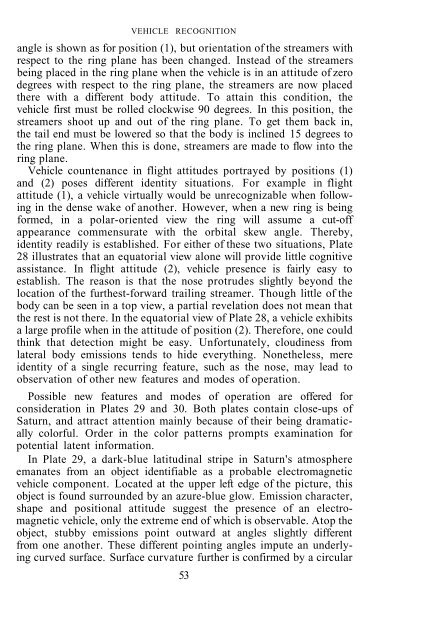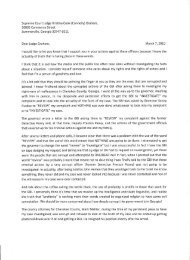Ringmakers of Saturn PDF - Patrick Crusade
Ringmakers of Saturn PDF - Patrick Crusade
Ringmakers of Saturn PDF - Patrick Crusade
Create successful ePaper yourself
Turn your PDF publications into a flip-book with our unique Google optimized e-Paper software.
VEHICLE RECOGNITION<br />
angle is shown as for position (1), but orientation <strong>of</strong> the streamers with<br />
respect to the ring plane has been changed. Instead <strong>of</strong> the streamers<br />
being placed in the ring plane when the vehicle is in an attitude <strong>of</strong> zero<br />
degrees with respect to the ring plane, the streamers are now placed<br />
there with a different body attitude. To attain this condition, the<br />
vehicle first must be rolled clockwise 90 degrees. In this position, the<br />
streamers shoot up and out <strong>of</strong> the ring plane. To get them back in,<br />
the tail end must be lowered so that the body is inclined 15 degrees to<br />
the ring plane. When this is done, streamers are made to flow into the<br />
ring plane.<br />
Vehicle countenance in flight attitudes portrayed by positions (1)<br />
and (2) poses different identity situations. For example in flight<br />
attitude (1), a vehicle virtually would be unrecognizable when following<br />
in the dense wake <strong>of</strong> another. However, when a new ring is being<br />
formed, in a polar-oriented view the ring will assume a cut-<strong>of</strong>f<br />
appearance commensurate with the orbital skew angle. Thereby,<br />
identity readily is established. For either <strong>of</strong> these two situations, Plate<br />
28 illustrates that an equatorial view alone will provide little cognitive<br />
assistance. In flight attitude (2), vehicle presence is fairly easy to<br />
establish. The reason is that the nose protrudes slightly beyond the<br />
location <strong>of</strong> the furthest-forward trailing streamer. Though little <strong>of</strong> the<br />
body can be seen in a top view, a partial revelation does not mean that<br />
the rest is not there. In the equatorial view <strong>of</strong> Plate 28, a vehicle exhibits<br />
a large pr<strong>of</strong>ile when in the attitude <strong>of</strong> position (2). Therefore, one could<br />
think that detection might be easy. Unfortunately, cloudiness from<br />
lateral body emissions tends to hide everything. Nonetheless, mere<br />
identity <strong>of</strong> a single recurring feature, such as the nose, may lead to<br />
observation <strong>of</strong> other new features and modes <strong>of</strong> operation.<br />
Possible new features and modes <strong>of</strong> operation are <strong>of</strong>fered for<br />
consideration in Plates 29 and 30. Both plates contain close-ups <strong>of</strong><br />
<strong>Saturn</strong>, and attract attention mainly because <strong>of</strong> their being dramatically<br />
colorful. Order in the color patterns prompts examination for<br />
potential latent information.<br />
In Plate 29, a dark-blue latitudinal stripe in <strong>Saturn</strong>'s atmosphere<br />
emanates from an object identifiable as a probable electromagnetic<br />
vehicle component. Located at the upper left edge <strong>of</strong> the picture, this<br />
object is found surrounded by an azure-blue glow. Emission character,<br />
shape and positional attitude suggest the presence <strong>of</strong> an electromagnetic<br />
vehicle, only the extreme end <strong>of</strong> which is observable. Atop the<br />
object, stubby emissions point outward at angles slightly different<br />
from one another. These different pointing angles impute an underlying<br />
curved surface. Surface curvature further is confirmed by a circular<br />
53



